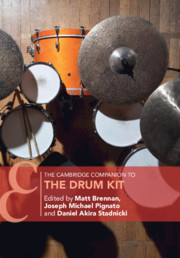Book contents
- The Cambridge Companion to the Drum Kit
- Cambridge Companions to Music
- The Cambridge Companion to the Drum Kit
- Copyright page
- Contents
- Figures
- Tables
- Music Examples
- Notes on Contributors
- Introduction
- Part I Histories of the Drum Kit
- Part II Analysing the Drum Kit in Performance
- Part III Learning, Teaching, and Leading on the Drum Kit
- Part IV Drumming Bodies, Meaning, and Identity
- 14 The Meaning of the Drumming Body
- 15 Disability, Drumming, and the Drum Kit
- 16 Seen but Not Heard
- 17 Building Inclusive Drum Communities
- 18 A Window into My Soul
- Index
16 - Seen but Not Heard
Performing Gender and Popular Feminism on Drumming Instagram
from Part IV - Drumming Bodies, Meaning, and Identity
Published online by Cambridge University Press: 28 May 2021
- The Cambridge Companion to the Drum Kit
- Cambridge Companions to Music
- The Cambridge Companion to the Drum Kit
- Copyright page
- Contents
- Figures
- Tables
- Music Examples
- Notes on Contributors
- Introduction
- Part I Histories of the Drum Kit
- Part II Analysing the Drum Kit in Performance
- Part III Learning, Teaching, and Leading on the Drum Kit
- Part IV Drumming Bodies, Meaning, and Identity
- 14 The Meaning of the Drumming Body
- 15 Disability, Drumming, and the Drum Kit
- 16 Seen but Not Heard
- 17 Building Inclusive Drum Communities
- 18 A Window into My Soul
- Index
Summary
The drum kit is one of the most explicitly gendered instruments in Western popular music, while drumming culture continues to be male-dominated. Despite the visibility of drummers like Anika Nilles, Taylor Gordon, and Sarah Thawer, women and gender non-conforming drummers remain underrepresented at both amateur and professional levels. This is slowly changing in the digital age, as social media platforms like Instagram provide opportunities for drummers from underrepresented groups to form online communities, make themselves visible, and participate in popular discussions regarding the instrument, musical performance, and gender politics. Nowhere is this more apparent than on ‘Drumming Instagram’, where women and gender non-conforming drummers can connect, learn, and find inspiration from each other. Although social media can enhance the visibility of underrepresented percussionists, is Instagram a space where emancipatory feminist politics can emerge? We answer this question by conducting a content analysis of user comments (n=3,370) from three Instagram accounts dedicated to promoting women drummers: @femaledrummers, @tomtommag, and @hitlikeagirlcontest. Our findings suggest that social media visibility both legitimizes women drummers while rendering them vulnerable to public scrutiny and unwanted attention. Although Drumming Instagram makes it easy for women to be seen, it nevertheless remains challenging for feminists to be heard.
- Type
- Chapter
- Information
- The Cambridge Companion to the Drum Kit , pp. 222 - 234Publisher: Cambridge University PressPrint publication year: 2021
- 1
- Cited by

